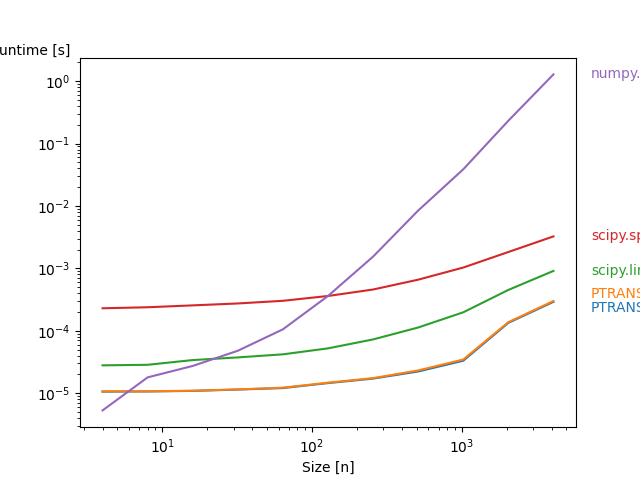Note
Go to the end to download the full example code
4. Example: Performance for full matrices
Here we compare all algorithms for solving pentadiagonal systems provided by pentapy (except umf) using a full quadratic matrix as input.
To use this script you need to have the following packages installed:
scipy
perfplot
matplotlib

Overall ━━━━━━━━━━━━━━━━━━━━━━━━━━━━━━━━━━━━━━━━ 100% 0:00:00
Kernels ━━━━━━━━━━━━━━━━━━━━━━━━━━━━━━━━━━━━━━━━ 100% 0:00:00
import numpy as np
import perfplot
from pentapy import solve, tools
def get_les(size):
mat = (np.random.random((5, size)) - 0.5) * 1e-5
V = np.array(np.random.random(size) * 1e5)
M = tools.create_full(mat)
return M, V
def solve_1(in_val):
"""PTRANS-I"""
mat, V = in_val
return solve(mat, V, is_flat=False, solver=1)
def solve_2(in_val):
"""PTRANS-II"""
mat, V = in_val
return solve(mat, V, is_flat=False, solver=2)
def solve_3(in_val):
mat, V = in_val
return solve(mat, V, is_flat=False, solver=3)
def solve_4(in_val):
mat, V = in_val
return solve(mat, V, is_flat=False, solver=4)
def solve_5(in_val):
mat, V = in_val
return np.linalg.solve(mat, V)
perfplot.show(
setup=get_les,
kernels=[solve_1, solve_2, solve_3, solve_4, solve_5],
labels=[
"PTRANS-I",
"PTRANS-II",
"scipy.linalg.solve_banded",
"scipy.sparse.linalg.spsolve",
"numpy.linalg.solve",
],
n_range=[2**k for k in range(2, 13)],
xlabel="Size [n]",
logy=True,
)
Total running time of the script: (0 minutes 37.452 seconds)